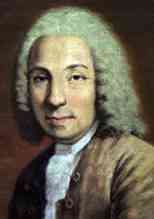


Carl Stamitz
Source: Classical Connect
Baptized in Mannheim on 8 May 1745, Carl (more properly Karl) Stamitz was the eldest son of Johann Stamitz and elder brother by five years to Anton Stamitz [Stamitz family of composers]. Introduced to music by his father, he also trained under Christian Cannabich. Stamitz composed above 50 symphonies, more than 38 symphonie concertantes and at least 60 concertos. He was early employed as a violinist by the court in Mannheim, the latter of especial importance to the classical period. Carl was perhaps five years old when his father, Johann, became director of the Mannheim orchestra in 1750. He himself joined the orchestra at age seventeen in 1762. Mannheim was hardly the only place in Europe where baroque got shaped through galant into classical, but it was probably the most famous at the time, known for the virtuosity of its performers as well as its composers who popularly published farther off in Paris and London as well. What is called the Mannheim School wasn't a formal organization, but is an umbrella title for its contributions to the classical style, such as leaving basso continuo to history along with the fugue, minimizing counterpoint. The Mannheim School contributed variously to classical symphony, such as in the usage of strings and winds. Perhaps its most famous innovation was the employment of crescendo called the Mannheim Rocket. Come also its use of silence in the complete rest called the Grand Pause.
Carl was about age twenty-five when he left Mannheim to travel as a virtuoso in 1770, his itinerary to include Paris, London (where he performed with his brother, Anton), Saint Petersburg, the Low Countries, Prague and Germany. He published his first book in Paris in 1770, his Op 1 that is 'Six Quartets' [Badley]. But Karl is among composers with confused opus numbers, for there is a second Op 1 published in Frankfurt no later than 1774 titled 'Viola Concerto' in D major [IMSLP]. Nor do opus numbers indicate chronology very accurately with such as Op 8 and Op 18, for example, broadly said to be published in 1773. His Op 19 below is another of which there are two, one for quartets by bassoon or clarinet with strings, another called 'Six Duets' for violin and cello. I'll not attempt a consuming explanation of such discrepancies, which are numerous, here, but only make a note of them as I leave you with their mystery. There is otherwise no authoritative verseichnis or directory of complete works prepared for Stamitz. Titles below are an attempt at chronological order, disregarding opus numbers, with the exception of 'Cello Concerto No.1' for which the date of composition is unknown.
'Quartet' E-flat major Op 8 No.4 Karl Stamitz
Published in Berlin 1773
Scored for clarinet or oboe / violin / viola / cello
Nuovo Quartetto Italiano Oboe: Alessandro Baccini
'Viola Concerto' D major Op 1 Karl Stamitz
Published in Frankfurt no later than 1774
Scored for viola / 2 clarinets / 2 horns / strings
Qingdao Symphony Orchestra / Zhang Guoyong
Viola: Máté Szücs
'Flute Concerto' G major Op 29 Karl Stamitz
Published c 1780
Scored for flute / strings
Youth Music Monterey County / John Larry Granger 25 Feb 2012
Flute: Hayoung Youn
'Quartet No.5' B-flat major Op 19 Karl Stamitz
Published 1786?
15th Esbjerg International Chamber Music Festival 2013
Violin: Ernst Kovacic Viola: Steven Dann
Bassoon: Etienne Boudreault Cello: Anssi Karttunen
'Cello Concerto No.1' G major Karl Stamitz
Date unidentified
Kurpfalz Chamber Orchestra Cello: Klaus-Peter Hahn
Having married one Maria Josepha Pilz sometime in the eighties, Stamitz settled with his family of four children in Jena, Germany, in 1794. He died in poverty on 9 November 1801. He had apparently been a student of alchemy, as papers on the subject were found among his belongings. The philosophical study of alchemy is thought to have originated in the first few centuries AD in China, India and the Mediterranean region each independently. By Stamitz' time it had been separated as an occult pursuit from chemistry which science it had helped to develop mainly along the way of attempting to create gold. Alchemy had also been much connected to the practice of medicine, concerning which charlatans in no small number continue, unseparated, to this day.
Sources & References for Carl Stamitz:
VF History (notes)
Audio of Stamitz:
Classical Archives Classical Connect Hyperion Naxos Presto
Compositions: Corpora:
Allan Badley (discussion) Klassika Luck's Music Riemann (symphonies)
The Mannheim School (1720-81):
Chris Whent (HOASM)
Recordings of Stamitz: Catalogs:
45 Worlds All Music Discogs Metason Music Brainz RYM
Scores:
Abe Books (vendor)
Amadeus (vendor)
Gallica (digital copies)
IMSLP
(digital copies)
Internet Archive
(digital copies)
Musicalics
(vendor)
Authority Search:
BNF Data
Deutschen Nationalbibliothek
VIAF
Other Profiles:
Monica Cuneo (Viola In Music)
David Mason Greene (Biographical Encyclopedia of Composers / Doubleday / 1985)
Classical Main Menu Modern Recording
|
|
hmrproject (at) aol (dot) com